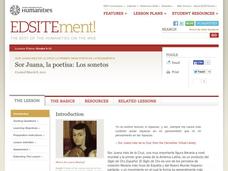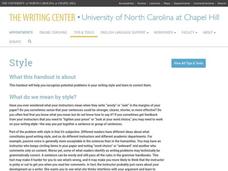Curated OER
Column Addition, 4-Digit Numbers
Just follow the columns! Young mathematicians complete 16 addition problems with five addends each. They examine two examples before doing these, and the example problems demonstrate carrying one and two into the next column. Encourage...
Curated OER
2-Dimensional Shapes: Naming Shapes
Get to know eight shapes by name: square, rectangle, triangle, pentagon, hexagon, and octagon. Young geometers write the correct name below each of these shapes, using a word bank for guidance. Then, they draw two of the shapes (hexagon...
Curated OER
Introduce Vocabulary: Clifford's Family (Bridwell)
Do you know Clifford, the big, red dog? Clifford takes an adventure to see his family, and young readers join him to learn some new vocabulary in context! Before reading, introduce the four new words: city, county,...
Curated OER
Introduce Vocabulary: Franklin Goes to the Hospital (Bourgeois)
Franklin the turtle is on another adventure in Paulette Bourgeois' book Franklin Goes to the Hospital, and there are plenty of new words for your young readers to explore as they hear this story. Although you can include more, you'll...
Curated OER
Introduce Vocabulary: Froggy Goes to School (London)
Just like your budding readers may have felt, Froggy is nervous on his first day of school. Use Johnathan London's book Froggy Goes to School to practice vocabulary in context. Prior to reading the story aloud, pre-teach the new words...
Curated OER
Introduce Vocabulary: Have You Seen Bugs? (Oppenheim)
Are your scholars interested in bugs? Get future entomologists excited about vocabulary through Joanne Oppenheim's colorful book Have You Seen Bugs? They use the informational text (although this strategy is useful for any book) to learn...
Curated OER
Introduce Vocabulary: "I Can't," Said the Ant (Cameron)
With both rhyme and a fun storyline, Polly Cameron's story "I Can't," Said the Ant is a useful resource for vocabulary in context. Emerging readers focus on five key words: cooperate, mend, nimble, sling, and trickle. After a brief...
Curated OER
Introduce Vocabulary: Make Way for Ducklings (McCloskey)
Use the Caldecott Award-winning book Make Way for Ducklings by Robert McCloskey (which can be found on YouTube if you don't have it) to guide budding readers through vocabulary in context. Although the instruction here is limited to the...
Curated OER
Introduce Vocabulary: Miss Bindergarten Stays Home (Slate)
What is Miss Bindergarten up to now? Joseph Slate's story Miss Bindergarten Stays Home is an excellent resource for budding readers to practice five vocabulary words in context: advise, lesson, lovely, strum, and substitute. As they...
Curated OER
Introduce Vocabulary: Miss Spider's Tea Party (Kirk)
Learning new vocabulary words is best done in the context of an engaging story like David Kirk's Miss Spider's Tea Party. New readers (or almost-readers) focus on any of 12 new words: conceal, courtesy, demand, descend, dread, fragile,...
Curated OER
Introduce Vocabulary: My School's a Zoo (Smith)
Your classroom may feel like a zoo sometimes, but it's nothing like this! Stu Smith's book My School's a Zoo is an excellent way to introduce some fun vocabulary words in context, and it's available on YouTube in case you don't have it....
Curated OER
Introduce Vocabulary: Over in the Meadow (Keats)
If you're reading the classic story Over in the Meadow, consider this strategy to cover vocabulary in context with budding readers. After a brief introduction, listeners raise a hand when they hear each word (bask, burrowed, and cawed)...
Curated OER
Introduce Vocabulary: Owen and Mzee: The True Story of a Remarkable Friendship (Hatkoff & Kahumbu)
The heartfelt true story of Owen the hippopotamus and Mzee the 133-year-old tortoise will have budding readers engaged as they practice vocabulary in the context of Isabella Hatkoff's nonfiction story. Although you could include more,...
Curated OER
Subject-Verb Agreement
Perfect for a middle school classroom, this two-page reference guide introduces subject-verb agreement and gives 10 specific explanations and examples. Then, independently, attempt the 15 sentences that follow. Learners must select the...
Curated OER
Where the Red Fern Grows Chapter 10-11 Worksheet
Focus on characterization in Wilson Rawls' well-known novel. First, learners answer a series of questions about the chosen chapters, paying attention to plot, use of language, and character interactions. Then, using the provided Venn...
National Endowment for the Humanities
A Wrinkle in Time: The Board Game
Tackle some big questions about A Wrinkle in Time by Madeleine L'Engle with a board game project. As learners brainstorm for and complete their board games, they consider what helps and hinders Meg on her journey and why she succeeds in...
National Endowment for the Humanities
Sor Juana, la poetisa: Los sonetos
Examine two of Sor Juana's sonnets in depth. Learners first listen to an audio recording or a reading of the sonnets and then analyze the structure and form, paying attention to elements of the Baroque and el gongorismo. Assess student...
Curated OER
Current Event Report
Make sure your class spends some time paying attention to the news by asking individuals to report on a current event. Using this sheet, pupils write down the title, source, and date before composing a brief summary and a personal...
EngageNY
Getting the Job Done—Speed, Work, and Measurement Units II
How fast is your class? Learners determine the amount of time it takes individuals to walk a given distance and calculate their speeds. Pupils solve distance, rate, and time problems using the formula and pay attention to the rate units.
West Corporation
Making Inferences – Use Your Mind to Read!
How can you tell if someone is happy? The lesson works with elementary and middle school scholars to activate their schema and pay attention to details to make inferences in their daily lives, poetry, and other literature. Cleverly...
University of North Carolina
Style
Just like you choose your clothes to ensure they fit the occasion, you should choose your words deliberately while writing. Style, the main topic of one handout in a series on writing skills, involves choosing words carefully and paying...
Population Connection
The Carbon Crunch
Carbon is in the air; should we care? Teach the class why it is important to pay attention to carbon levels and how the world population and various countries across the globe affect the carbon levels in the atmosphere. High schoolers...
Mathed Up!
Collecting Like Terms
Gather all similar terms together. Initially created to aid in the review of the General Certificate of Secondary Education, the resource provides opportunities to practice collecting like terms in algebraic expressions and multiplying...
University of Waikato
Buoyancy in Water
Change where an object floats in water. Pupils experiment with a Cartesian diver by squeezing on the side of a plastic bottle. Learners pay attention to the bulb of the pipette as the bottle is squeezed to determine what is happening...

























